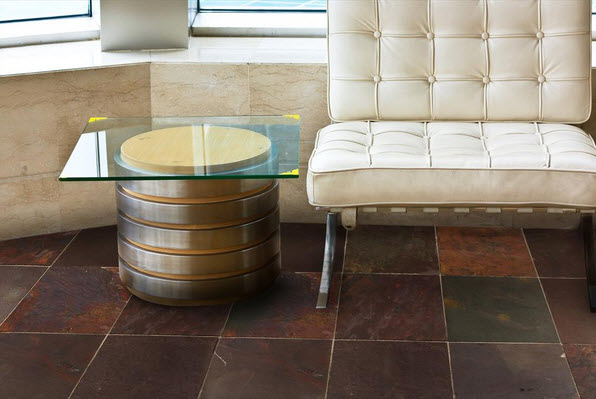How to Seal Slate
Slate is a stylish, elegant flooring material that can be bring beauty to interior and exterior spaces. Known to resist breaks, cracks and scratches, slate is a natural stone material that provides incredible long-term durability even in high-traffic spaces.
While many people like the rough, raw look of slate, adding a sealant can help protect your floors and add a unique style to your space. Keep reading to learn more about why and how to seal slate.

Why Should You Seal Slate?
The look of natural slate is something many people love. That look will change as your slate ages though. Some people enjoy this natural transition, while others would prefer their slate flooring to look brand new forever. If you fall in the brand new camp, sealing your slate could be an ideal choice.
Sealing slate also provides protection from spots and stains since slate is a somewhat porous natural material. Applying a coat of sealant can also give your slate a slightly gloss or wet look that adds shine to your design.
What Type of Sealant Should You Use?
Not all sealants are made the same. The type you choose can impact the look of your slate and the longevity of the seal. Here are a few common types of sealant you can use on slate:
Oil-Based Sealant
Designed to offer more protection that lasts longer, oil-based sealants penetrate deeper into the slate. They’re also associated with more fumes and a higher cost. Using oil-based sealant requires greater care during application.
Water-Based Polyurethane Sealant
This sealant type is more economical and easier to apply. However, it doesn’t provide the same deep penetration and it likely won’t last as long. High shine styles may not be quite as vibrant if you opt for a water-based polyurethane sealant either.
Consider Your Desired Look
There are two main types of sealant used for slate and other natural stone. More than two different looks are possible however. Here are a few different looks you can achieve when sealing slate:
Matte
Ideal for preserving slate with minimal changes to its natural look, matte sealants are a popular pick for both traditional and modern designs.
Glossy
Giving your slate a permanent wet look, glossy styles work well with more modern décor. Many people use high-gloss sealant outside to give their decks and patios a more contemporary appearance.
Semi-Gloss
Bridging the gap between mate and glossy, semi-gloss sealants give your slate an extra shine that’s more understated than wet look designs. If you like both matte and glossy slate, semi-gloss could be an excellent middle ground choice.
DIY or Pay a Pro?
Learning how to seal slate isn’t the most difficult task you can take on. In fact, savvy individuals with a little DIY flooring experience may be able to save money by doing the work themselves.
However, it’s important to note that learning how to seal slate and completing the job can be time consuming. Doing it completely alone and without help may also be very difficult. If you’ve never worked with natural stone before or you don’t have experienced help, hiring a professional crew may produce a better outcome.

DIY Steps
- Choose your desired sealant. Always spot test your sealant on an extra piece of slate you can spare if it doesn’t work as desired.
- Ensure that your subsurface is clean. Debris, dirt or other grime on your subsurface can impact your slate installation negatively.
- Determine how you plan to seal your slate. You can apply sealant with a spray applicator, brush, roller or even a sponge. Different tools can provide slightly different looks.
- Seal each piece of slate individually following the manufacturer’s instructions. Make sure you give your sealed slate proper time to dry before applying a second coat.
- Lay your tile using appropriate grouting techniques. Mixing grout with sealant instead of water may provide better moisture resistance. Note that not all sealant manufacturers recommend this.
- Apply your desired surface finish once your grout has had time to set and properly cure.
- Clean your slate and grout about 10 to 14 days later. Once cleaned and all excess grout has been removed you can apply an additional clear coat for extra protection if desired.
Sealing your slate flooring can provide protection from spots, spills and stains while preserving its first-day style. Using sealants can also give your slate a semi-gloss or high-gloss shine that many people love.
Interested in learning more about slate flooring materials for your indoor or outdoor spaces? Reach out to our knowledgeable representatives now. They can help you find the right materials and tell you more about how to seal slate properly if you want to tackle the project on your own.


